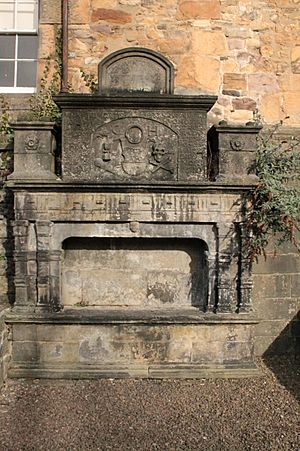George Heriot (died 1610) facts for kids
Quick facts for kids
George Heriot
|
|
|---|---|
| Born | 1539/40 |
| Died | 1610 |
| Nationality | Scottish |
| Occupation | Goldsmith commissioner to parliament from edinburgh |
| Children | George Heriot |
George Heriot (born around 1539 or 1540, died 1610) was a skilled goldsmith from Scotland. He was also a member of the Scottish Parliament. He is most famous for being the father of George Heriot, who became a very wealthy and generous person. His son later founded a famous school in Edinburgh called Heriot's Hospital.
Contents
Who Was George Heriot?
George Heriot was the son of another goldsmith, also named George Heriot. His father moved to Edinburgh in the early 1500s. His mother was Christian Kyle, who was from Edinburgh. The Heriot family was well-known in Haddingtonshire. George's grandfather, John Heriot, received land for his military service.
His father worked for King James V. For example, in 1533, he repaired a silver jug for the king. George Heriot himself lived and worked in the Canongate area, just outside Edinburgh's main walls.
George Heriot's Career as a Goldsmith

By June 26, 1561, George Heriot became a "freeman" of the Edinburgh Goldsmiths' group. This meant he was a recognized and skilled goldsmith. He was then chosen as a "quarter-master" for the group. In August 1562, he became a "burgess" of Edinburgh. This meant he was a full citizen with certain rights.
He was elected "Deacon" of the Goldsmiths' group many times. A Deacon was like the head or leader of the craft. He also became "deacon-convener" of all the city's trade groups five times. This was a very important role, showing he was respected by many different trades.
George Heriot in Parliament
George Heriot also served as a representative for Edinburgh in the Parliament of Scotland. He did this many times between 1585 and 1607. In 1596, he was part of a group sent to meet King James VI. They wanted to calm the king after a big riot in Edinburgh. The riot had made the king leave the city.
In 1597, he joined a special group to decide the value of foreign gold and silver money. In 1599, he worked on a plan to reissue Scotland's money. His last act in Parliament was in 1607. He helped assess a tax to print Regiam Majestatem, which was a book of old Scottish laws.
George Heriot was buried in Greyfriars Kirkyard in Edinburgh. His grave has a very fancy monument.
Notable Works by George Heriot
In October 1579, when King James VI first entered Edinburgh, he received a special gift. It was a cupboard full of silver-gilt items. George Heriot and other Edinburgh goldsmiths made these pieces. The gift was worth a lot of money, about 1000 English marks. It included basins, flasks, cups, candle holders, and silver plates.
Some letters from Heriot still exist today. They show what he was working on around 1570. These items included a gold needle, a needle case, and gold buttons. He also worked on a "hinger" with a picture and a toothpick.
George Heriot's Family Life
George Heriot was married more than once. His first wife was Elizabeth Balderstone. Their first son, also named George Heriot, was born on June 15, 1563. They also had another son, Patrick, and a daughter, Margaret.
Later, George Heriot married Christian Blawe. With her, he had two sons, James and Thomas. They also had four daughters: Christian, Sybilla, Janet, and Marion. Christian, his wife, lived longer than him.
When his eldest son George got married in 1586, George Heriot gave him money. This helped his son start his own goldsmith shop. This son, George, became a very successful jeweler to Queen Anne and King James VI. He earned a huge fortune. He used this money to create Heriot's Hospital in Edinburgh. This hospital was a school for poor children.
After his brother George died, James Heriot became the court jeweler. He married Elizabeth Jossey in 1624 or 1625. His daughters Christian, Janet, and Marion were all married by 1623. Sybilla married in 1626.
His son Patrick moved to Genoa, a city in Italy. He married into an Italian family there. Records also show that George Heriot had another son named David around 1560. David followed in his father's footsteps and became a goldsmith. David's son, also named David, became a famous goldsmith too.
| Article contributor: Ray Harriot. Ray is a Historian of the Herriott Heritage Association and the author of “Beyond Trabroun: The Heriots of Scotland (1400-1700)” and “A Historical Perspective: The Heriot and Herriott Families of South Carolina”. |


